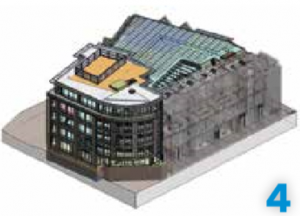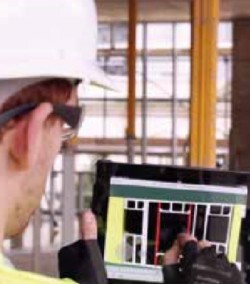Winning the BIM/Digital Construction Award at this year's Offsite Construction Awards highlighted Metsec's position at the forefront of the construction industry's drive towards a digitised future. It is also testament to the company's belief in the benefits of BIM and collaborative construction. Ryan Simmonds, Sales Director for Framing at Metsec, explains more.
Everyone in the construction industry is aware that BIM stands for Building Information Modelling. It is the process of designing, constructing or operating a building, infrastructure or landscape asset using electronic information. In practice, this means that a project can be designed and built using datasets and images digitally, even before the first spade goes in the ground.
At Metsec, we prefer to see the 'M' standing for Management, where BIM becomes far more than a modelling tool for design. Properly implemented, BIM instils a disciplined approach to the entire construction process, from design through to completion as well as the future management and maintenance of the building.

Collaboration Delivers Benefits
BIM facilitates a truly collaborative approach to construction, allowing designers, contractors, systems manufacturers and installers to function as a true team, working seamlessly towards the finished project, streamlining communications, eliminating errors and delivering time and cost efficiencies. In the offsite construction arena, BIM provides exceptional potential to exploit the benefits of collaboration, with all disciplines co-ordinating their efforts and activities towards a common goal - customer satisfaction! True collaboration from the outset of a project means that designs, issues, priorities and construction methods are all agreed at the initial stages and fully understood by all parties, eliminating, or at least minimising, room for error.
The benefits run throughout every stage of a project - the designer's vision is translated into working drawings with precise detailing, materials and systems specifications, and schedules agreed well ahead of onsite activity. This allows all those involved in the process to see how different elements affect their area and iron out any anomalies. At design stage, for example, working on the Queen Square project in Bristol, Metsec's ability to provide fully-detailed Revit files showing the cold rolled steel elements of the SFS infill walling solution in 3D allowed contractors, Skanska to see how the system would integrate with the wider structure and achieve the best performing framing solution for the project. At later stages, collaboration between the framing system manufacturer, framing installer and main contractor ensures that materials are manufactured, delivered and installed at the right times, obviating the need to store materials on site for prolonged periods and reducing waste in time and money.
BIM Leads the Way BIM offers a structured, measured and comprehensive approach to team working, with a fixed set of processes and procedures to guide users and participants on how best to employ collaborative methods. Design co-ordination is an involved process fraught with potential pitfalls and BIM's regular data exchanges ensure that the whole team is working on the same, and most up-to-date, model, allowing possible conflicts to be flagged and dealt with promptly and before they are implemented. The objective of BIM is to satisfy the three components of a successful project, namely time, cost and quality, by managing the project using an efficient, collaborative and reliable method of work. Sharing a 3D model with all parties communicates the planned end result in a clear, concise and fully comprehensible way, enabling the entire project team to understand the requirements and see what they are working towards. The information held within the model can be extracted from Cobie files. Within these, if done to Level 2 standard, the manufacturer will host the correct file extensions and product parameters to allow asset management in future years.

BIM, BEP, BIP
However, another crucial element of BIM is the promotion and adoption of collaborative working. The digital designs, including product parameters, are shared with all parties to outline the work planned and give everyone the opportunity to fully understand what is proposed and all the requirements, including specifications such as fire and acoustic data. The BIM Execution Plan (BEP) is a critical document as it underpins project integration and brings together all of the tasks, processes and related information. The BEP should be agreed at the outset and defines what BIM means for the project. It outlines the standards being adopted, outputs required, when these should be supplied and in what format, plus any supporting documentation. As a working document, the BEP is regularly being reviewed and evolving throughout the project, ensuring design teams, suppliers, manufacturers and all other stakeholders have all the relevant information, engendering collaboration between all parties. The BIM Implementation Plan (BIP) is the blueprint for integrating BIM into an organisation's working practices. This should align to the objectives and aspirations of the organisation, its business partners, its skill base, levels of investment and the nature and scale of projects that it wishes to undertake now and in the future. Hosting these documents in a centrally co-ordinated Common Data Environment (CDE) means they can be updated, accessed or extracted at any time throughout the project. Adding all other BIM documents, including the 3D drawings, gives all those involved in the project full visibility and input, promoting a collaborative approach throughout.

Delivering Results
At Metsec, BIM is part of our strategic vision. We were one of the first companies to recognise the benefits that it brings and became an early adopter of the technologies and disciplines essential to its successful implementation. It is now at the core of our framing business and is delivering real results for us and our clients. Our investment in, and commitment to, BIM has seen us become the first Tier 2 Designer and Manufacturer, complying with BIM Level 2 for design and construction in the UK and the first manufacturing company to receive the BSI Kitemark for BIM. Uniquely, we have also secured ISO 27001 status, enabling our BIM models to be encrypted for sensitive government projects. Our approach has seen improvements in collaboration, design time, manufacturing time and accuracy, all of which adds up to greater efficiency in the construction process and, ultimately, enhanced customer satisfaction.
For more information visit: www.metsec.com









